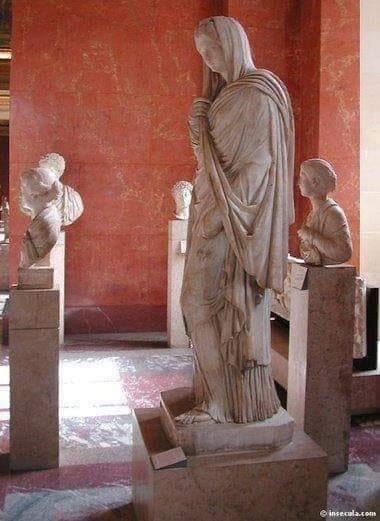The Libyan statue displayed in the Louvre Museum)

This Libyan statue is displayed in the Louvre Museum under the number (1130). This statue is one of the oldest statues that were looted from Benghazi and transported to France in the late seventeenth century. It is also considered the oldest statue known to Europe among Libyan antiquities.
The statue represents a woman standing, leaning on her right leg, with her left leg moving forward to maintain balance, with the head tilted slightly towards the left and bent forward slightly, and the facial features show a touch of beauty.
The eyes were left without any sign of the pupil or pupil, while the eyebrows were lightly engraved. The most prominent feature of this statue is the way the hair is styled, which appears divided in the middle and straight on the sides, in the form of many, regular waves. The rest of the hair is gathered at the top of the head in the form of two rows of braids or folds.
The woman is completely covered with an abaya that covers the top of the back of her head and extends down to below the knees
The two ends of the abaya gather at the right side of the body and drop to the bottom, where she holds it with her left hand, so nothing is visible from it except her fingers. She places the right hand on the chest as if she is holding the abaya at her chest for fear of it falling. Under the abaya, she wears a garment in which there are many vertical folds at the bottom that are distinctive. About the light horizontal folds of the abaya

The Greeks and Romans sought complete resemblance in their artwork to real-life figures
The father of history, Herodotus, mentioned that the dress and armor of the statues of Athena were transmitted by the Greeks from Libyan women, and this garment that the Greeks transmitted from Libyan women is a long garment that wraps the body and includes the shoulders, and the woman girds the rest of it and wraps it around her waist.
The dress of ancient Libyans is still a traditional dress prevalent in all societies of ancient Libya
In present-day Libya, it is called the butterfly, the scarf, or the robe.
The scholar Kaj Birket Smith confirms in his book (The Paths of Culture, Paths of Civilization), which was published in 1965 AD, that Roman dress was copied, meaning that he took it from ancient Greek dress, and that the Greeks transferred the abaya or garment from the ancient Libyans.
According to France's claim, the statue dates back to the middle of the second century AD during the reign of the Roman Emperor Antoninus Pius 138-161)
But Libyan archaeologists confirm that it is much older than the era mentioned, as Benghazi was called Eusperides during the reign of the Greeks.
According to Greek myth, Eusperides is the mother or queen of the nymphs, the daughters of Atlas, who guarded the golden apples.

This statue was stolen from Libya in 1692 during the reign of the Ottomans through an agreement and reconciliation between the Turkish ruler of Tripoli, Muhammad Imam Dey, and France through the ruler of the French stronghold called Denis Dozo.
Article Five of the concluded agreement stipulated that the French be allowed to transport archaeological columns from Leptis Magna to France, among the antiquities that were transported, this unique historical statue being transported with them.
Source: websites

